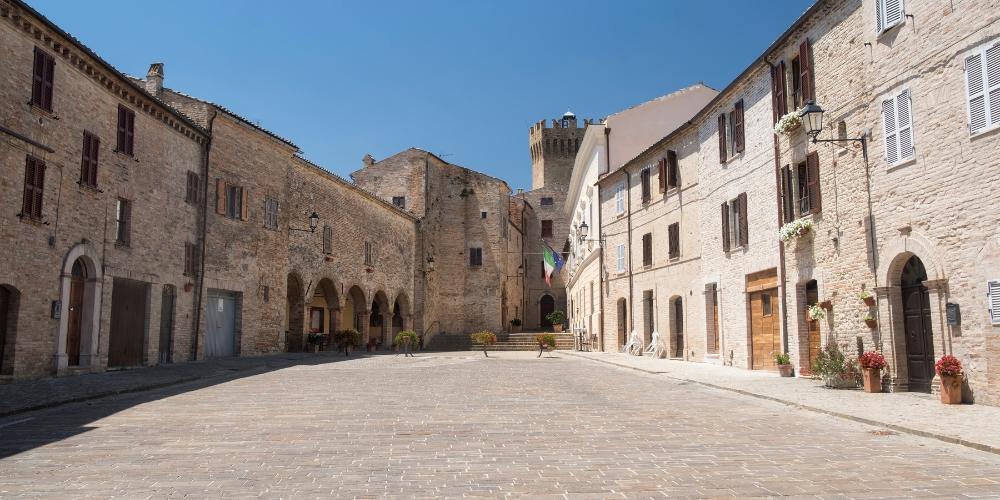From the 25-metre tower of Moresco, you can see an infinite panorama painted in green and blue. The green is that of the Marchigiana countryside, designed by Mediterranean vegetable gardens, olive groves and rows of vines, all defining the canonical slopes of the hinterland. The blue is that of the Adriatic Sea, which can be seen lapping the shore of Le Marche and sometimes even the Croatian coastline.
Moresco is located a short distance from Fermo, a cultured city rich in history, and is part of the circuit of I Borghi più Belli d'Italia. It's a miniature centre that overlooks and watches over the Aso valley. Looking at its position, it's easy to guess the defensive function the borgo held in past eras.
A past that is never really past because it structures the essence and charm of places like Moresco. You'll feel it blatantly as you pass through the narrow alleys and passages heading to the town's only piazza.
Immerse yourself in the 15th century and discover what to see in Moresco, an authentic (hidden) gem of the Marche region.

What to see in Moresco, an hidden gem of Le Marche

Moresco. An exotic name that conjures up scents of distant lands and adventurous stories. And yet, the origin of its name is less fancy than it would suggest. It seems to refer to a noble family or the dialect term 'morrecine', indicating the 'stony place' where the castle stands.
Speaking of the castle, notice that Moresco still retains the antique structure of a stronghold. People gradually populated the area from the Middle Ages onwards, turning the fortified centre into an authentic village whose urban layout dates back to the 15th century.
The particular elliptical conformation delineates Moresco's ancient defensive function. The town is crisscrossed by narrow streets and lanes all converging towards the square, the only one in the borgo. Triangular in shape, it's the beating heart of village life.
Under its porticoes (what remains of the left aisle of the old Chiesa di Santa Maria di Castro), locals and tourists gather to rest and chat at the sight of the stunning fresco by Vincenzo Pagani, the same author of the altarpiece housed inside the Palazzo Comunale.
Passing through the picturesque Clock Tower, you come across the former church of Santa Sofia. Known as lu teatrì, it has housed a small theatre since 2005 and contains a 15th-century fresco from the school of Carlo Crivelli.
Among the things to see in Moresco are the churches of Sant'Antonio and San Lorenzo and the palaces of Patrizio Gennari and Cardinal Capotosti. Beyond the walls are the temple of the Madonna della Salute and the church of Santa Maria dell'Olmo.
These are spots off the classic tourist routes that dot the Marche region with beauty. Take a look here to discover more.
What to see in Moresco: the castle and its tower
The heptagonal tower of the Moresco castle is the distinctive feature of the fortified village and certainly the detail that leaves one most amazed when visiting the town. Moresco owes its nickname of 'borgo of seven horizons' to it.
The reason for such an original shape, with the vertex seemingly pointing to Mount Sibilla, is still being determined. What is certain, however, is the spectacle that opens up as you walk up the modern internal staircase that traverses the tower's 25-metre height.
Up at the top, you don't spot enemies ready to battle but only the gentleness of an extraordinary landscape framed between Gran Sasso and Monte Conero.
The imposing construction dates back to the 12th century, but it has undergone various works that have partly modified its appearance over the centuries. For example, the Ghibelline battlements that surround it were made in the early 20th century following the collapse of the original arabesque spire.
Moresco, what to see in the surroundings

The area around Moresco is lovely in all seasons. For example, it's a delightful autumn destination perfect for admiring foliage (if you are passionate about the subject, we have just the thing for you here).
And what about local products? Cheese, cured meats, oil and wine: the gastronomic offer is prosperous, and there is no shortage of small producers around Moresco to stock up on tasty samples and 'souvenirs' to take home.
But the castle village of Moresco is only one of the stops not to be missed by those visiting Fermo and its province (by the way, here we give you lots more information). An ideal tour should also touch on Monterubbiano's churches and beautiful medieval buildings.
And continue to Campofilone, where you can visit the church of San Bartolomeo with its vegetable garden and feast on maccheroncini (what are we talking bout? We have told you everything here).
Towards the coast, Torre di Palme, a hamlet in the Fermo municipality, offers a romantic view of the Adriatic Sea and evocative routes through the nearby Cugnolo forest.
Moresco: festivals and events
Moresco is small and counts just 600 inhabitants, but throughout the year, many events, festivals and village traditions attract visitors to its timeless streets.
On the last Sunday in April, an outing to the rural church of Madonna dell'Olmo is customary. After the religious celebrations, everyone gathers for lunch on the meadow of the parish church.
Between June and August, Moresco is animated by music and outdoor performances, such as the beautiful initiative of Il Violino sulla Torre, a series of classical music concerts in the piazza.
Also in the square, on the third Friday in July, an exceptional dinner is staged: notes reminiscent of distant times resound in the air while costumed figures serve dishes prepared according to original medieval recipes.
In August, the historic polenta with clams festival is a must for gourmets. They'll also appreciate La Festa del Braciere in autumn, with chestnuts, skewers and sausages roasted in the square on the last Sunday in October.
About the author
Written on 08/12/2022


Lorena Calise
Discover what to see in Moresco, the small fortified village in Le Marche that hides wonders. Here's why you should visit it.